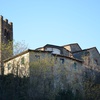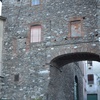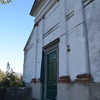Fort of Anchiano
The first mention of the fort of Anchiano can be found in a document from 925, which states the intention of the Suffredinghi family, following acquisition of the territory, to build there a castle and defensive walls.
Castle Anchiano was destroyed and subsequently reconstructed various times throughout the Middle Ages and today there are only a few remaining traces of the walls that surrounded the village. An image from the 17th century allows us to deduce that the village, located further down, was defended by a curtain of houses and a tower-gate to guard the main entrance.
In an elevated position on a rock cliff, the bell-tower of the church of St. Peter acted as a watchtower, while other walls, entered through a gate guarded by flanking semi-circular turrets, encircled the high ground.
The Church of St. Peter, dating from the 16th century, has a single nave with transept and choir in Romanesque style. The church underwent several renovations in the 17th century and was completed in 1850.
On the inside there is a aedicule for holy oils attributed to Andrea della Robbia and a triptych by the painter Bartolomeo Bocchi depicting the Madonna and Child with Saints, dating from the 15th century.
A path through the woods leads to San Giusto di Puticiano, a town abandoned around 1500 as a result of the plague, where you can find the ruins of an ancient church.











